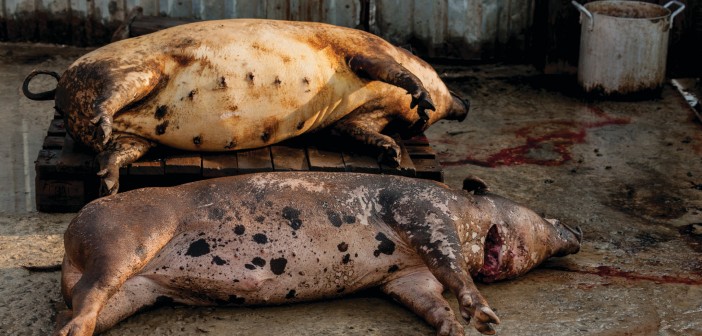The spread of African swine fever (ASF) over the winter in China is creating uncertainty on the global pork market, according to Rabobank.
In its latest global ASF update, Rabobank analysts highlight how the pig disease continues to actively influence pork markets around the world, mainly in China, but also in Germany.
China’s pig herd had been recovering rapidly since 2019, growing significantly in 2020, but this progress has been halted of late due to a combination of illegal vaccines, the emergence of new variants of the ASF virus, and pressure from other diseases, particularly porcine reproductive and respiratory syndrome (PRRS).
This has resulted in a rising piglet mortality rate and culling among the sow and hog herd in recent months. It is estimated that the sow herd dropped from December 2020 to February 2021, down 3% to 5% month-on-month in each month.
However, Rabobank analysts believe the current sow herd is still 10% to 15% higher than a year ago, and consider this ‘a setback during the upward trend of restocking rather than a turning point’.
“Moreover, the impact of ASF on overall pork production is lower than in 2019 and early 2020. Strong piglet and sow prices suggest that many farmers have sufficient confidence to restock,” the report said.
“As the hog population density increased in 2020 due to successful restocking and will continue to rise in the coming years, risks of ASF recurrences increase as well. Restocking will encounter headwinds from time to time in the coming years, and we maintain the view that full recovery will not be possible before, and more likely after, 2023.”
Rabobank still expects pork production to grow by 8% to 10% year-on-year in 2021, although this estimate has been adjusted downwards, ‘due to the headwinds created by the new wave of ASF outbreaks’.
“We believe pork production will continue to grow, as the sow herd has expanded on a year-on-year basis, despite the losses during the winter,” it says.
Justin Sherrard, global strategist – animal protein for Rabobank, said Chinese pork prices are expected to fluctuate due to the uncertainties of disease development, restocking interests, feed costs, and import policies.
“Our view is that average hog prices in 2021 will be lower than in 2020 and subject to strong ups and downs during the year,” he said.
Chinese pork imports
The implications of ASF for world pork trade are a ‘major swing factor in global pork markets’, Rabobank said.
China’s booming import demand for pork and other species was a major demand driver in global animal protein markets in 2020, but the forecast for China’s import demand in 2021 is uncertain – Rabobank expects China to import around 3.9m to 5m metric tons in 2021, with volumes 10% to 30% down from the record high of 2020. This is on the back of the forecast growth in China’s pork production in 2021, which is likely exceed 2019 levels.
China’s pork meat imports increased by a staggering 116% in 2020, mainly driven by the supply shortage in the domestic market, but is also partly attributed to market speculation on further increases in hog prices in China, Rabobank said.
Mr Sherrard said: “We see all exporting countries looking to maintain trade with China. Price will be one major factor that determines which countries will maintain high pork trade flows to China in 2021, along with availability and geopolitical considerations.”
Situation in Germany
The ongoing pressure from ASF’s spread in Germany is also significant, and while progress has been made in containing the disease, more work is needed, the report said. The situation in Germany has implications for other parts of Europe as well.
“After the ASF outbreak in Germany was confirmed in September 2020, 10 countries imposed import bans on German pork, including China, Japan, and Vietnam, leaving about an extra 70,000 metric tons of pork on the EU market each month,” according to Mr Sherrard.
Although a number of countries recently relaxed import bans on German pork, the import ban by China is likely remain in place at least for the first half of this year, ‘as the situation is still evolving’, he said.
The outbreak has already had a significant impact on piglet and live pig imports to Germany, and lower live animal imports will likely continue in 2021. From September to November 2020, piglet imports from Denmark and the Netherlands, the two major suppliers of piglets to Germany, dropped by 25% and 31% respectively compared to the same period in 2019.
This represents a total of 0.7m less head imported to Germany, approximately 1% of total slaughtered animals in 2020.




